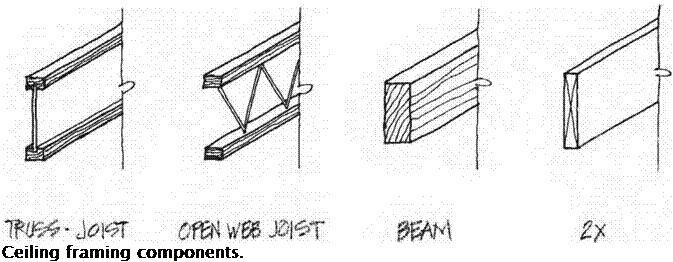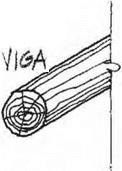Roof and Floor Framing
Solid beams, round logs, or 2X joisting are commonly used for shorter roof spans. Manufactured trusses, typically made of composite wood products and assembled into profiles engineered for strength, are commonly used for longer spans. They have several advantages over solid lumber. They are less expensive, use wood resources more efficiently, have greater span capabilities, provide a deep pocket for roof insulation, and can be fabricated with a built-in slope for flat roof application.
Truss joists, commonly called TJIs, are manufactured beams containing either plywood or dimensional lumber for top and
 |
 |
bottom chords, and either plywood or press – board for the webs. Because they are a very cost-effective way to frame large spans, truss joists are widely used in residential construction. The members are subjected to heat during manufacturing, which helps cure them, reducing the quantity of VOCs they emit into a new home. A small amount of formaldehyde remains. In new home construction, the cumulative effect of several low emissions can add up to unacceptable levels. Where an airtight gypsum board assembly or air barrier is applied between the structure and the living space, these fumes will be fairly insignificant. If there is still concern, however, the TJIs can be sealed. BIN Primer Sealer is particularly good for this purpose because the white color allows you to visually inspect the job and make sure everything has been well coated. Another option is to use open-web roof trusses with dimensional lumber for the top and bottom chords and webs, thereby avoiding the use of pressboard entirely.
Special Procedures for Interior Garage Walls
Ideally, to prevent harmful automobile fumes from entering the home the garage should not share walls with it. If this is not possible, a series of extra procedures should be followed:
• Follow procedures for airtight gypsum board installation (as outlined in Division 9) between garage and home.
• Apply Type X gypboard to garage walls per code.
• Use a solid core, weatherstripped door between home and garage.
• Thoroughly seal the door sill with one of the sealants listed in Division 7.
• Make all electrical penetrations in the wall airtight. (See section on gasketed electrical boxes in Division 16.)
• Seal and tape any plumbing penetrations between garage and home with aluminum tape.
• Provide automatic mechanical exhaust ventilation in the garage as outlined in Division 15.
Subflooring
Interior-grade plywood and particleboard are typically used for subflooring in standard construction. Urea-formaldehyde glues are used to bond the wood during manufacturing. This is a concentrated, volatile form of formaldehyde that contributes significantly to indoor air pollution. In addition, the subflooring may then be attached to the framing underneath with solvent-based glues that will also contribute to the pollution level.
Solid wood, as well as the cementitious subfloor sheeting more commonly used in commercial building, can be considerably more expensive, but exterior-grade plywood can substitute for interior-grade plywood for only a small increase in cost. While exterior – grade plywood contains less-volatile phenol – based formaldehyde glues, it will still release significant amounts of formaldehyde into the air when new. Airing out the wood by crossstacking it onsite is better than installing it immediately after delivery. Sealing the wood after it has been aired out will provide the most protection against toxic fumes and this extra step may be taken for chemically sensitive individuals. We suggest the following specifications for healthier subfloor installation: [8]
• structural cementitous sheeting
• їх finish floor boards laid parallel to walls over ix subfloor laid diagonally to walls may be a good solution when a finished wood floor is desired; verify for proper span conditions with the architect or engineer
• exterior-grade plywood that has been aired out; may be sealed with BIN Primer Sealer or another acceptable sealer on all six sides for extra protection for chemically sensitive individuals






Leave a reply